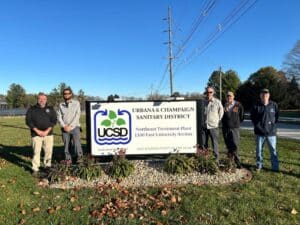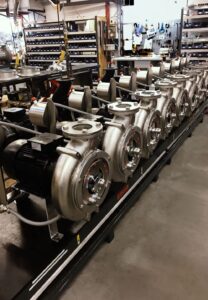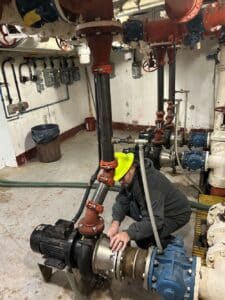By Matt Hale, Global Key Account Director, HRS Heat Exchangers The recent news that there…
MEMBER PRESS RELEASE – New Chopper Pumps enhance AD operation at Urbana & Champaign
MEMBER PRESS RELEASE – New Chopper Pumps enhance AD operation at Urbana & Champaign
Standards are very high at the acclaimed Urbana & Champaign Sanitary District (UCSD). Very High! Offering a one-year guarantee on your equipment? Think again.
When the team at this Illinois treatment facility looked to upgrade the pumps on three of its anaerobic digesters, a lifetime of around 20 years was expected.
Almost eight years in, and the pumps that were installed on the 500,000-gallon digesters, are, according to Justin Profancik, Director of Operations at UCSD, ‘very dependable, reliable and durable’.
Situated approximately 140 miles south of Chicago, UCSD’s digesters were built separately over a period of years at its Northeast Treatment Plant (NEP), which opened in 1924 (UCSD’s Southwest Treatment Plant opened in 1968). In 2016, it was time for an upgrade, especially as the existing pumps were clogging up more or less on a quarterly basis.

“The old units had done a pretty good job,” said Justin Profancik, “but weren’t Chopper Pumps (*invented by Landia in 1950), so the solids, rags and grit would gradually accumulate, causing them to clog. We then had to take them apart and clean them out, so there was a lot more maintenance involved then, compared to now.”
‘Maintenance department really likes the design’
“When we’ve inspected the Landia pumps (each 7.8HP) over the past seven years, there hasn’t really been anything of any major significance to worry about. On the Landia Chopper Pumps’ external knife system, you can change the blades easily. Our maintenance department really likes the design.”

Created over a century ago by voter petition, UCSD is a municipal body that provides wastewater treatment for properties in the Cities of Urbana and Champaign, as well as the villages of Bondville and Savoy. It also serves the University of Illinois (56,000 students). It is not a part of any other local, municipal, county, township or state government. Today, it employs 50 people, including 10 operation staff.
At UCSD’s Northeast Treatment Plant (NEP), solids management facilities include gravity belt thickeners to thicken waste activated sludge (WAS); a sludge receiving station that receives thickened waste activated sludge (TWAS) from the UCSD Southwest Plant (SWP), industrial WAS, high strength waste (HSW) from grease-hauling trucks and a small amount of food waste from a Hershey’s (chocolate) truck wash and the University of Illinois. There is also a tank that blends sludge from the receiving station with NEP TWAS and primary clarifiers; four anaerobic digesters (three of which are now served by the Landia Chopper Pumps); a digested sludge storage tank; and three centrifuges to dewater the digested sludge. The dewatered biosolids, which meet Class B biosolids requirements, are land-applied as soil amendment to agricultural fields.
Digester gas produced in the anaerobic digesters is used in combined heat and power (CHP) engines to cogenerate electricity and heat for the NEP, as well as export electricity to the grid.
‘Protecting downstream equipment’
“We call the Landia units our recirculation pumps,” continued Justin Profancik, “but (stored in the basement of our AD complex) they are part of the heating cycle, effectively working as recirculation pumps through our heat exchangers to heat the digesters. We used to have to clean the heat exchangers out about once per month, but with the Landia Chopper Pumps continuously chopping and reducing the particle sizes of the sludge, this is only required about once per quarter – and in those quarters, a lot of times, we’re usually not really finding anything, even in the small veins of the heat exchanger. It shows in this case that top quality pumps play a big part in protecting downstream equipment.”
Since the installation of the Landia Chopper Pumps for the UCSD digesters, gas production has increased; hitting a record high of 400,000 cubic feet per day. Typically, though, it is around an average of 190,000.
‘Hershey truck wash’
Justin Profancik added: “Although the food waste we take in from the Hershey truck wash is less than one per cent of our feedstock, we can see the difference in gas production immediately.”

As a District that likes to use its money very effectively and efficiently, UCSD more than did its research into the new pumps that it needed for its digesters. This culminated in visiting Landia’s manufacturing facility in Lem, Denmark, which came about through the Water Technology Alliance (WTA), an outreach program to share valuable water technology solutions between the North American and Danish water sectors. Wade Lagle, previous Director of Operations at UCSD (who has over 40 years’ experience in wastewater treatment), explained.
“Seeing where and how the pumps were made gave us very positive reassurance,” he said. “The quality control and cleanliness of the facility was second to none. It is a wonderful production facility. We could see that the Landia Chopper Pump is very well designed, and that it would be a very good fit for our digesters, low on maintenance, highly effective, and with a long lifetime. Total cost of ownership is very important to us.”
Justin Profancik continued: “Installation was very straightforward, and because the pumps haven’t had any major issues, we’ve not had to make that much contact with Landia, but when we do, they’re always there with help and advice, wanting to ensure that everything is right. We’ve had really great success with the Landia Chopper Pumps.”
